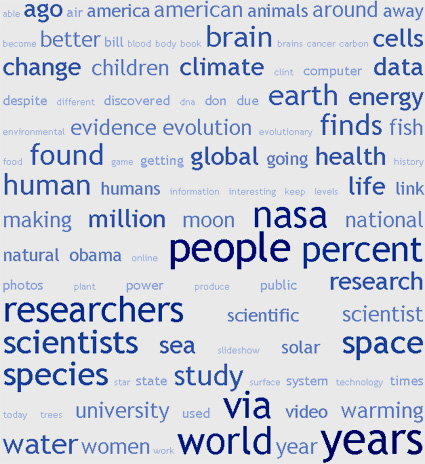
ideonexus 2009 Science Links Tag Cloud
The National Ignition Facility went online, focusing the power of numerous high-powered lasers on a single point to produce the environment inside a star… but then we didn’t hear anything else about it. Space Shuttle Discovery took a bat to space clinging to the external fuel tank. Scarlet Knight became the first robot to traverse the Atlantic ocean autonomously. A 7.3 billion-year-long race between photons ended with a photo-finish. Everquest 2’s 60 terabytes of log files provided a wealth of data to behaviorists. An octopus in a California disassembled a valve at the top of her tank to flood the aquarium with 200 gallons of seawater. Mysteries solved this year include the 1908 Tunguska explosion being caused by a comet and DNA evidence proving the death of the Czar’s daughter Anastasia. The LHC smashed the world power record and had its first particle collisions. Best of all, They Might Be Giants released their awesome album Here Comes Science.
Steven Colbert Rocks
 Combined Operational Load Bearing External Resistance Treadmill Credit: NASA |
It was a great year for science-supporter and genius satirists Steven Colbert. After a write-in campaign caused his name to win naming-rights to a new room on the ISS, NASA responded by asserting their right to name the module themselves and considered naming the toilet after Colbert, but eventually deciding to name the treadmill “Combined Operational Load Bearing External Resistance Treadmill” (C.O.L.B.E.R.T.). The satirist also got a diving beetle, Agaporomorphus colberti, named after him.
The Flu Pandemic
The H1N1 virus (aka. Hamthrax) turned the whole world into a laboratory and revived interest in Six Degrees of Kevin Bacon. A vaccine was out less than a month after strains were provided to clinics. It became a full-scale pandemic in June, has claimed 11,500 lives as of December 25th, and the strain will define future flu bugs for years to come.
Diet, Exercise, and Intelligence
2009 added to the already strong body of evidence linking diet and exercise to cognitive function. With research on rats appearing to show that active rats grow neurons capable of handling stress, a study finding that it’s exercise, not fitness, that improves body self-image, fatty foods affecting exercise performance and them triggering long-term memory formation. A nutrition program in China boosted student performance and students who ate fish twice a week achieved higher intelligence scores. Exercise is linked to better cognitive function in older women, improving kids’ academics, and aerobic activity keeping the brain young.
President Obama

President Barack Obama
Without a doubt, the most positive development in science for the year has been the election of President Barack Obama. After a stellar first week, it seems as though the American Government is treasuring science more than it has in years. With the Solar Decathlon on the Washington Mall, a Middle East Science Envoy, establishment of National Lab Day and Computer Science Week, and most recently the Educate to Innovate STEM initiative, there’s good news on the science front in politics every month. One of my favorites has been the appointment of America’s CIO Vivek Kundra, who is ushering in a new era of government transparency with data.gov and the Policy Forum on Public Access to Federally Funded Research. The stimulus bill included a great deal of funding for scientific research and education which may be tracked at recovery.gov and the science-specific spending at Science Works for US, and although the money funding science won’t be spent quickly, it will have the effect of strengthening America’s position as an innovator years down the road.
The Future
We know that having fat friends increases our chances of being fat too, suggesting a social-pressure factor in obesity. So maybe it isn’t such a surprise that emerging research indicates that mental illnesses spread through social networking sites and that open-source communities foster groupthink.
While newspapers struggle to find a way to survive in the digital age, are universities next to die as people are able to self-educate online? A rift in an Ethiopian desert will eventually become a new ocean. Children born today have good chances of living to see the year 2100, when they may get to see the fantastic glory of full-grown hybrid Chestnut trees being reintroduced to America today.

American Chestnut
My Favorite Articles from 2009:
